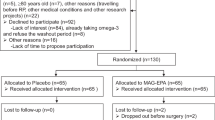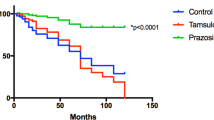Abstract
Finasteride is widely used for the treatment of benign prostatic hyperplasia (BPH). Its therapeutic efficacy is believed to be mediated through selective inhibition of prostatic 5α‐reductase (type II). This prospective, controlled, randomized study examines various relationships between changes in tissue 5α‐reductase isozyme activity, epithelial proliferative index and morphology in men with BPH treated with finasteride for 6 months, and correlates these with clinical response.
Thirty‐one patients presenting with symptomatic bladder outflow obstruction were prospectively randomized to receive either finasteride or placebo (2:1) for 24 weeks. Of these, 27 men aged 55–80 y (median 69 y) completed the study, including 18 patients on treatment. Symptom score determination, uroflow and prostate volume were assessed at baseline and end of study. Prostatic tissue was obtained by ultrasound‐guided needle biopsy at baseline and by transurethral resection (TURP) at end of study for biochemical and morphometric analysis. Epithelial proliferation was examined quantitatively in the resected tissue using MIB‐1 antibody to Ki‐67 and counting the percentage of positively staining cells.
Type II 5α‐reductase activity was strongly inhibited by finasteride in resected BPH tissue, with over 100‐fold decrease in Vmax (P=0.001), whereas the type I isozyme was inhibited 5‐fold (P=0.005). Selective inhibition of type II 5α‐reductase was demonstrated in all treated patients. No significant difference in epithelial proliferation was observed between the finasteride and placebo groups. Epithelial proliferation was, however, greater in prostatic tissue with histological manifestation of inflammation (2.02% vs 0.89%, P=0.001). Positive correlation between the total epithelial volume and the ratio of transition zone volume/total prostate volume was observed in the placebo group (r=0.834), whereas there was no such correlation in men taking finasteride (r=−0.300), consistent with a reduction in epithelial content in the treatment group. Improvement in uroflow and reduction in prostatic volume in patients treated with finasteride did not reach statistical significance.
This study shows that finasteride causes inhibition of 5α‐reductase activity in human BPH tissue with selectivity for the type II isozyme. In spite of this, no significant effects in epithelial proliferation or tissue morphology were demonstrated. The presence of inflammation was, however, associated with significantly greater proliferative activity. The power of this study was limited by the small number of recruited patients, and a larger study would be required for further investigation of morphological changes induced by finasteride in BPH tissue and their biochemical basis.
This is a preview of subscription content, access via your institution
Access options
Subscribe to this journal
Receive 4 print issues and online access
$259.00 per year
only $64.75 per issue
Buy this article
- Purchase on Springer Link
- Instant access to full article PDF
Prices may be subject to local taxes which are calculated during checkout
Similar content being viewed by others
Author information
Authors and Affiliations
Rights and permissions
About this article
Cite this article
Feneley, M., Span, P., Schalken, J. et al. A prospective randomized trial evaluating tissue effects of finasteride therapy in benign prostatic hyperplasia. Prostate Cancer Prostatic Dis 2, 277–281 (1999). https://doi.org/10.1038/sj.pcan.4500377
Received:
Revised:
Accepted:
Published:
Issue Date:
DOI: https://doi.org/10.1038/sj.pcan.4500377
Keywords
This article is cited by
-
SRD5A2 gene expression inhibits cell migration and invasion in prostate cancer cell line via F-actin reorganization
Molecular and Cellular Biochemistry (2015)
-
Urine chemokines indicate pathogenic association of obesity with BPH/LUTS
International Urology and Nephrology (2015)



